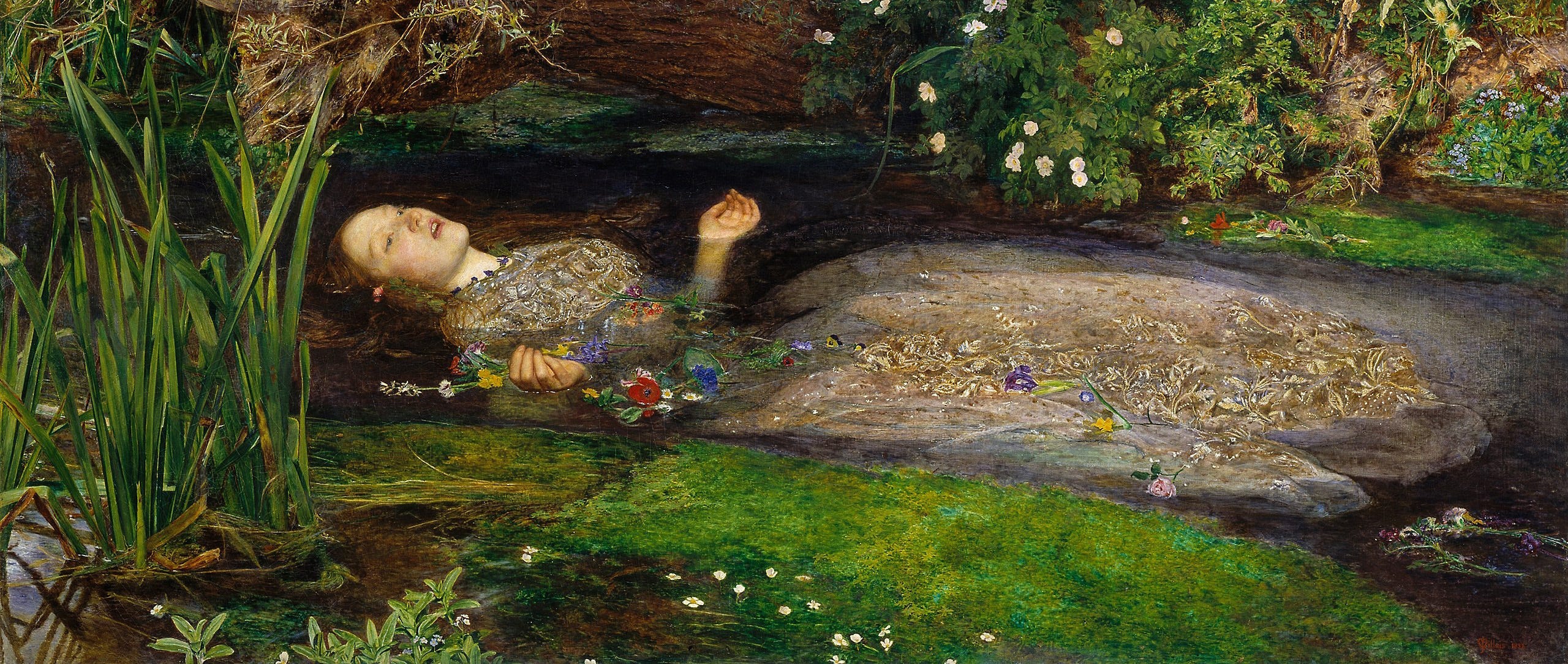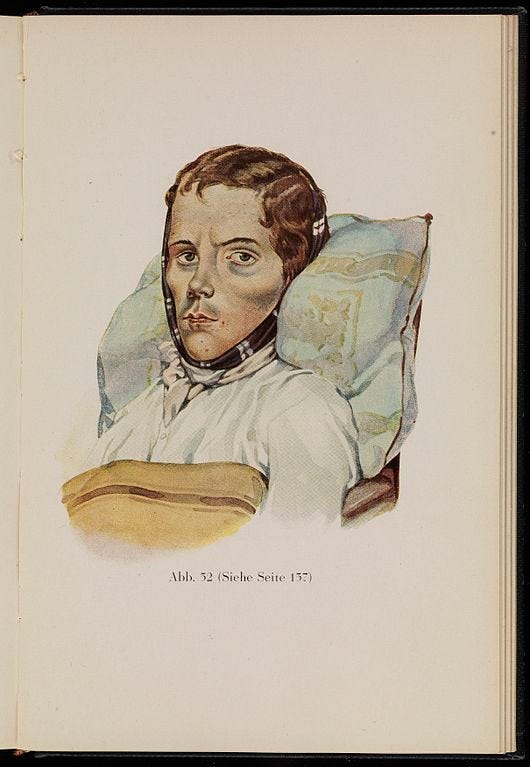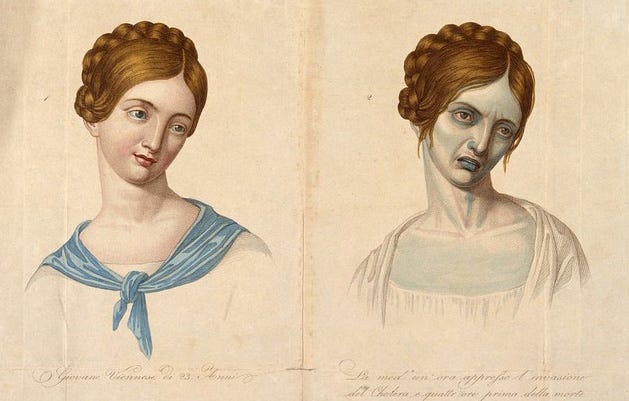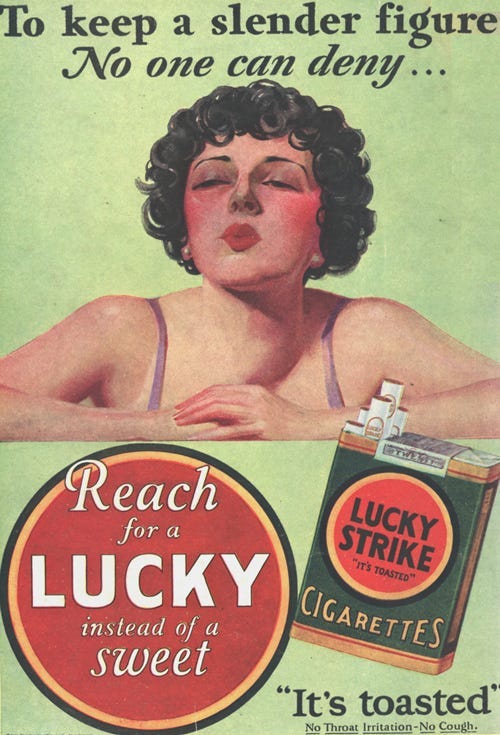Death Becomes Her: Thin, Frail, and Dying Were Once The Beauty Ideal
Now, this dangerous beauty trend is back.

Grim Reminder: A Grim Historian is a reader-supported newsletter and depends on your 5$ donations to keep the most depressing politics and history in your inbox. Please consider becoming a paid subscriber or share with someone who loves misery.
There’s a new beauty trend popular with celebrities and influencers. It’s now not enough to be a size zero. You must also have cheekbones so chiseled that they could cut glass.
These sunken cheeks are from Buccal (pronounced “buckle) Fat Removal — a cosmetic surgery to remove the fat pads in the lower part of the cheeks. The surgery takes approximately 30 minutes and will set you back about $2-4000. Best of all, it’s permanent, so you can keep that “I just escaped from a crypt” look for the rest of your deathless life.
Celebrities rumored to have their cheek fat sucked off include; Anya Taylor-Joy, Khloe Kardashian, Sophie Turner, Zoe Kravitz, and supermodel Amelia Gray Hamlin.
While this might seem like another silly TikTok trend, you won’t find much originality on TikTok.
No, they stole this one from the Romantics. Check out those cheekbones…

This man’s prominent cheekbones make him appear effeminate, but he did not get his supermodel angst through surgery. He got those cheeks the hard-won way — wrestling with death.
In the nineteenth century, women with this emaciated appearance were called “consumptive beauties,” and her weight loss technique was guaranteed to melt the pounds away faster than you can say keto.
It began with a lingering cough that splattered tiny droplets of blood across white handkerchiefs. As the bacterium multiplied, she grew thinner and thinner. Bones protruded through gossamer skin in sharp angles. Cheeks burned crimson with fever. Eyes sunk into their orbs, glassy and desperate. And then, in her final unforgiven hour, her chest shook with a chorus of gasps, wheezes, and rattles. Each fragile inhalation, a whispered plea to unfurl the hand of death across her specter-thin neck.
She was Delicate. Dying. And devastatingly beautiful.
Cue Chopin…(who also died the same beautiful death).

Some called it the “wasting sickness” because it literally wasted away someone’s body. Other names were the White Death, graveyard cough, or, most commonly, consumption.
After 1830, it became known as tuberculosis (TB) — a bacterial infection as old as antiquity. Only one in 10 people infected got active TB, but the infection could linger for decades before the final breathless blow.
It might seem odd today to conflate death with beauty, but the consumptive’s fragility gave her a self-possessed air. She faded in slow, graceful measures. A once-robust woman blurred into a thin, frail, pale, oh-so-tragic beauty.
It wasn’t long before advertising and literature extolled the virtues of the consumptive heroine. Fashion plates were shaded in the clavicle to make women look bonier. Women colored their cheeks with white powder and a feverish red to emulate the final stages of the disease. Dresses were even cut at a sloping angle to make the shoulders appear hunched and diminutive. (When tuberculosis infects the spine, it causes a hump.)
Women flushed with intellectual curiosity or hedonistic dancing were not blessed with this beautiful death. Those book-reading hussies got the far more disfiguring cholera or smallpox. Or so the logic went.

“Consumption, I am aware, is a flattering malady.” — Charlotte Brontë on learning she had consumption
It was believed this sickness did not consume everyone. It targeted artists, poets, authors, and anyone with a more sensitive bent. The list of famous consumptive authors is long; John Keats, Lord Byron, George Orwell, Henry David Thoreau, Franz Kafka, Anton Chekhov, and almost the entire Bronte family.
However, it wasn’t only poets dying from tuberculosis. At its height between 1780–1850, tuberculosis caused 25 percent of total European deaths and 1 in 7 deaths in America. That’s a lot of beautiful deaths.
Unfortunately, no one understood how tuberculosis was spread. When tuberculosis took John Keats at 25, all his furniture was burned to contain the contagion. The fires were unnecessary. TB is not spread on surfaces but in tiny droplets in the air.
In 1882, Dr. Robert Koch announced the discovery of Mycobacterium tuberculosis — the bacteria that causes tuberculosis (TB). Once consumption was understood to be a bacteria and not brought on by too many poetry readings, attitudes changed.
The other beautiful destroyers
At the turn of the century, the leisure class was on the move, and fragility lost its allure. However, the pressure to stay thin remained, and overweight women were valued less in the marriage market.
Whenever there is fear, greedy manufacturers will monetize it. One such unscrupulous industry was tobacco.
Before the 1920s, cigarette smoking was viewed as unladylike. Only showgirls and ladies of the night (prostitutes) smoked. Tobacco manufacturers saw an opportunity — rebrand cigarettes to upper-class women as a weight loss aid.
One Lucky Strike advertisement chided, “Reach for a Lucky instead of a sweet.” Many women did.
Who needs TB to ravage your lungs when tobacco can do the job faster?

After WWII, women moved into the spheres of men, and frailness lost its romanticism. Rosie the Riveter flexed her bicep, and Marilyn Monroe sashayed across the screen with bodacious curves. Thin was out. The hourglass figure was in. Advertisements from this period even shamed thin women as unlovable, bony shrews whose hard flesh would send any man running for a rounder, softer mistress.
In the 60s, models such as Twiggy were popular, but waif-like thinness didn’t go mainstream again until the “Heroin Chic” beauty ideal of the 1990s. High fashion celebrated Kate Moss’s size-zero body, sharp cheekbones, and rockstar edginess.
Suddenly, it was cool to snort cocaine in the bathroom and eat tissue paper to suppress your appetite. Women were beautiful if they had the correct “thigh gap” — the space between your thighs when your ankles touched. It’s no wonder that anorexia and bulimia rates skyrocketed in young girls during this period.
“…glorifying death is not good for any society.” — Bill Clinton after the death of Davide Sorrenti
In the 2000s, Thinspo influencers kept their chokehold on young girls’ psyches. The loveable Bridget Jones mirrored women’s shame. She couldn’t find a man because she was (gasp!) 136 pounds.
Now, thinness is trending again. Influencers are injecting the diabetes drug Ozempic to lose pounds while obsessing over “snatched” fashions — clothes that hold those jiggly bits in.
Even more dangerous is the latest “waif girl” trend. Much like the heroin chic of the 90s, the waif girl is a tortured soul who is unapologetically rude, depressed, drug-addicted, and embracing her eating disorders. She lacks self-regulation with everything but food.
Recently, TikTok influencers have even toted makeup tutorials on how to create dark circles under your eyes or look like you have been crying.
Apparently, sleeplessness and sadness are now hot.
We have seen these beauty ideals before. But it’s not only the return to thinness that will harm women. It’s the return to conflating suffering with beauty.
A wasted mind is the new wasted lung.
Carlyn Beccia is an award-winning author and illustrator of 13 books. If you enjoyed this article, please share this publication with friends. Wednesday's article is always free. Sunday's article is available only for paid subscribers.





